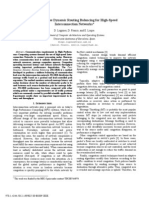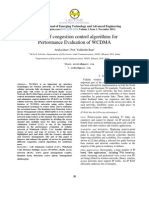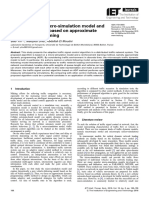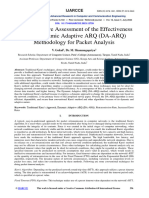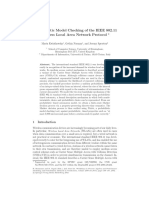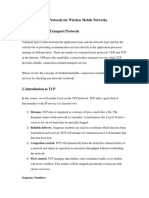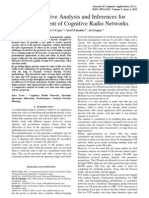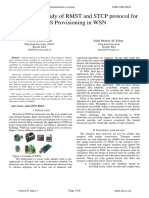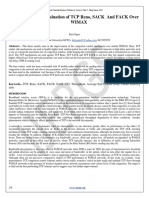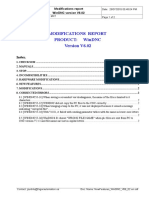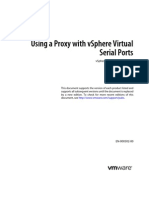Alman Filter Based Ongestion Ontroller: Mehdi Mohtashamzadeh
Alman Filter Based Ongestion Ontroller: Mehdi Mohtashamzadeh
Uploaded by
ijdpsCopyright:
Available Formats
Alman Filter Based Ongestion Ontroller: Mehdi Mohtashamzadeh
Alman Filter Based Ongestion Ontroller: Mehdi Mohtashamzadeh
Uploaded by
ijdpsOriginal Description:
Original Title
Copyright
Available Formats
Share this document
Did you find this document useful?
Is this content inappropriate?
Copyright:
Available Formats
Alman Filter Based Ongestion Ontroller: Mehdi Mohtashamzadeh
Alman Filter Based Ongestion Ontroller: Mehdi Mohtashamzadeh
Uploaded by
ijdpsCopyright:
Available Formats
International Journal of Distributed and Parallel Systems (IJDPS) Vol.4, No.
3, May 2013
DOI : 10.5121/ijdps.2013.4307 85
KALMAN FILTER BASED CONGESTION
CONTROLLER
Mehdi Mohtashamzadeh
Department of Computer Engineering, Soosangerd Branch, Islamic Azad University,
Soosangerd, IRAN
Mohtashamzadeh@gmail.com
ABSTRACT
Facing burst traffic, TCP congestion control algorithms severely decrease window size neglecting the fact
that such burst traffics are temporal. In the increase phase sending window experiences a linear rise which
may lead to waste in hefty proportion of available bandwidth. If congestion control mechanisms be able to
estimate future state of network traffic they can cope with different circumstances and efficiently use
bandwidth. Since data traffic which is running on networks is mostly self-similar, algorithms can take
advantage of self-similarity property and repetitive traffic patterns to have accurate estimations and
predictions in large time scales.
In this research a two-stage controller is presented. In fact the first part is a RED congestion controller
which acts in short time scales (200 milliseconds) and the second is a Kalman filter estimator which do
RTT and window size estimations in large time scales (every two seconds). If the RED mechanism decides
to increase the window size, the magnitude of this increase is controlled by Kalman filter. To be more
precise, if the Kalman filter indicates a non-congested situation in the next large time scale, a magnitude
factor is calculated and given to RED algorithm to strengthen the amount of increase.
KEYWORDS
Kalman filter, Self similarity, congestion control
1. INTRODUCTION
Ever increasing amount of data in networks may lead to congested networks, routers with full
queues, increase of loss rate, and end-to-end latency. As a result effective throughput in networks
would be plummeted. To deal with such challenges routers have to route packets faster and more
precise. Towards this end congestion control algorithms have developed to enable the dramatic
growth of networks, especially Internet. The original idea ([1]) was to adjust the transmission rate
based on the loss probability. The first implementation of this mechanism was named TCP Tahoe
and later refined into TCP Reno, New Reno, RED, REM and etc. These algorithms are now the
dominating transport protocols on the Internet.
Almost all congestion control mechanisms cannot utilize available bandwidth since they react late
and harsh to traffic bursts and cannot effectively recover network as they increase sending
window size in a slow conservative linear manner. Admittedly, such manner may protect network
resources from high level contentions. However, if mechanisms be able to get aware of network
status in near future, they can control the magnitude of window size increase or decrease. Since
network traffic imitate Heavy-tail distribution [2-4] and have Long Range Dependency (LRD)
and self-similarity, network parameters can be predicted. Unfortunately, most network protocols
International Journal of Distributed and Parallel Systems (IJDPS) Vol.4, No.3, May 2013
86
have been designed according to Poisson probability distribution of network traffic. Researchers
have proposed two main solutions, first to overwrite network protocols and other to modify
existing control mechanisms to gain from self-similarity and LRD property. Current work belongs
to the second solution and tries to improve the performance of TCP RED mechanism [5] using
mathematical concept of Kalman filters to estimate Round Trip Time (RTT) and window size
parameters in large time scales considering the fact that traffic is self-similar and repeated in time.
As a light and precise estimation tool, Kalman filter has widely been deployed by researchers to
control congestion in data networks. Authors of [6] have studied RTT estimation as a suitable
parameter to control congestion using network state information. Investigating the characteristic
of RTT and the application of the estimation, they concluded that the estimation objective is to
keep the estimate smooth but still able to capture sudden mean changes. As a result a Kalman
filter combined with CUSUM change detection was proposed and shown to perform well based
on results of experiments on real data.Hoon Yang et al. [7] have proposed an LQ-Servo control
mechanism with observer for TCP/AQM system. The controllers structure is composed of a
traditional servo mechanism based on Linear Quadric approach. In order to estimate the state of
TCP window packet size, they facilitate the control structure with a Kalman filter based
observer.Last but not least, in [8] an Extended Kalman Filter based bandwidth estimation module
which is capable of providing highly accurate link capacity estimations. Authors claim that their
protocol-independent non-packet-probing module is distinct from other bandwidth estimators in
two ways; firstly, rather than directly measuring link capacity, the module uses the persistent
queue size and associated parameters. Second, their proposed module is claimed to overcome the
degradation of the network utilization problem resulted by an increasing bandwidth value. They
demonstrated that both XCP and VCP protocols with EKF-based Bandwidth Estimator could
overcome the limitations of the original protocols and achieve significant performance
improvements in network utilization by eliminating the protocol oscillatory behaviour.
2. TCP-RTT
In random early detection (RED) [5], packets are dropped before the buffer is full, with a
probability that increases with the queue length. RED can thus be seen as a way of indirectly
signalling the queue length to the source. RED is window-based which means that each sender
has a window that determines how many packets are allowed to be sent at any given time. The
transmission rate is regulated by adjusting this window.
During congestion avoidance phase the congestion window size (W) of senders grows linearly
which cause linear increase in queue length. This growth continues as long as weighted average
queue length (X) remains belowq
mn
; if X exceeds this threshold system should go through the
delayed drop-notification phase. This phase is governed by a count-down timer I
k
which expires
in exactly one round trip time (m
k
). During this some queued packets are dropped base on their
calculated drop probability. This phase ends with the expiration of the I
k
timer, after which the
congestion window W is cut in half and a new timerI
k
, is used which is initialized to the value of
the current round trip time. Third phase is called recovery in which senders are not permitted to
transmit packets, the congestion window W is kept fixed and the queue is going to be empty. This
phase lasts for 0.5m
k
.In the last phase which also lasts 0.5m
k
senders are allowed to transmit
packets but the congestion window W is still kept fixed resulting in no change in queue length.
The controller returns to the congestion avoidance phase after the expiration of m
k
timer.
International Journal of Distributed and Parallel Systems (IJDPS) Vol.4, No.3, May 2013
87
cwnJ=
cwnJ +
1
cwnJ
congcstion o:oiJoncc
cwnJ +
1
cwnJ
JcloycJ notiicotion
cwnJ rcco:cry (not scnJing)
cwnJ rcco:cry (scnJing)
As it can be seen in the above equation window size increase in congestion avoidance and
Delayed notification phases is done in a linear manner which may reduce performance
according to bandwidth waste. This shortcoming is challenged in this research and details are
presented in the following section.
3. SELF-SIMILARITY OF TRAFFIC IN LONG TIME SCALE
Crovella et al. [9] studied 500 thousand of web requests. Senders were assumed as on/off traffic
generators.They found that overall generated traffic is self-similar. In addition, authors of [10]
have shown that in most cases Ethernet local networks traffic is burst and self-similar. Moreover,
TCP, Telnet, and FTP traffic types have been studied by authors of [11]. They understood that
Poisson model which has been the dominant model of network traffic for plenty of years is not
compatible with burst property of traffic in different time scales. Last but not least, research
results of [12] depict that VBR traffic can easily be modelled by Heavy-Tail distribution, thus it is
self-similar. In accordance with these demonstrations, self-similarity can be considered to
improve network throughput via predicting network status.
4. KALMAN FILTER BASED CONGESTION CONTROLLER
The proposed design of current research is a two-stage controller (Fig. 1). The first part is a RED
controller which function in short time scales and the second part is a Kalman filter which tries do
estimate RTT and window size parameters every three seconds (long time scale) keeping in mind
that traffic is self-similar and traffic patterns are repeated in long time scales.
The mathematical model of classic congestion controllers may serve their purpose well in most
cases but the assumptions of the mathematical model are not correct in all circumstances, for
example, presence of a very large number of network nodes and packet-flows may affect the
calculations up to a fractional level which can accumulate into a high level of measurement
uncertainty when the results are used as feedback control [13]. Moreover, a RED algorithm which
operates on a router at some congested link and uses the exponentially weighted-average-queue-
length to predict packet losses and impose flow control may use wrong parameters (weights) and
can consequently lead to uncertainties. The aim of State Estimation is to separate the signal of
interest from the measurement uncertainties and filter out the noise. Kalman filter State Estimator
is used here to achieve these goals. The reason of Kalman filter selection is the well-known
property of feedback systems. Feedback can compensate for model uncertainty. This is one of the
properties which explain the broad usage of Kalman filters.
The proposed controller functions as follows. If the estimated value of window size shows a rise
and the estimated RTT depicts a fall in comparison with the last long time scale, aggressiveness
factor () is calculated and sent to the first part of the controller. The RED algorithm can use this
factor to strengthen the amount of increase in congestion avoidance and Delayed notification
phases considering the fact that in the next long time scale network may experience low level of
contention (based on Kalman filter estimations). Although the long time scale controller can be
International Journal of Distributed and Parallel Systems (IJDPS) Vol.4, No.3, May 2013
88
implemented just based on RTT estimations, controller accuracy would be increased in case of
using window size estimations along with RTT estimations.
Figure 1.Two-stage congestion controller. The first part has a short time view of network, while the second
part makes long time predictions according to self-similarity property of traffic patterns
Six congestion levels have been considered for the simulated network based on average () and
deviation () of RTT estimates. Each level can be mapped to a period [x,y) of RTT in which x
and y are computed according to the following equations. It is worth noting that periods are
recomputed at the end of every long time scale.
< < |
.
|
\
|
+
=
=
m k k
m
k
x
1 1
2
1
= +
< < +
=
=
m k
m k x
k
m
y 1
1
2
) 2 (
m stands for quantity of levels in these equations.
In accordance with the above equations, six traffic levels results to six ranges of RTTs which are
listed below:
(-, -2) [-2 , - ) [- , ) [, + ) [+ , +2 ) [+2 , )
Aggressiveness factor can then be calculated considering predicted traffic level (L).
= (1/L) A
A is maximum value of Aggressiveness factor. As a result, increase equation of RED algorithm
can be represented as follow,
cwnJ=
cwnJ +
cwnJ
congcstion o:oiJoncc
cwnJ +
cwnJ
JcloycJ notiicotion
cwnJ rcco:cry (not scnJing)
cwnJ rcco:cry (scnJing)
International Journal of Distributed and Parallel Systems (IJDPS) Vol.4, No.3, May 2013
89
The more the quantity of levels are, the more precise the controller will be. However, having
more levels means more computational overheads.
4.1 Kalman filter estimators
There are two estimators functioning in the second part of the controller, one to estimate RTT
value and the other one to provide window size estimations. RTT estimation models equations
are as follows,
RII
k
= A RII
k-1
+ B u
k
+
k-1
_
k-1
= om
k-1
(o {0,1})
A = 1
B = 0
(1)
Z
k
= RII
k
+ I
k
(2)
Furthermore, time update and measurement update equations are listed in Table 1.
Table 1. Time update and measurement update equations of RTT estimator
time update measurement update
RII
k
=
RII
k-1
+o
k-1
m
k-1
P
k
= P
k-1
+
K
k
=
P
k
P
k
+ R
, R = :or(I
k
)
RII
k
= RII
k
+ K
k
[Z
k
RII
k
P
k
= (1 K
k
)P
k
+ o
t-1
,
= :or(m
k-1
)
The difference between the sampled RTT value and estimated RTT depicts the amount of
measurement noise in each long time scale.
I
k
= Z
k
RII
k
(3)
If sum of measurement noise till the current time scale exceeds a predefined threshold (0.05 in
simulations), this noise should be considered in calculations (Y
k-1
> 0). Otherwise, measurement
noise is considered to be zero.
S
t
= S
t-1
+ V
k
i S
t
> trcsolJ tcn
t
= 1 , S
t
= 0
Else
t
= 0
The window size estimator has similar equations as follows,
w
k
= A w
k-1
+B u
k
+
k-1
, u
k
= on
k-1
(4)
International Journal of Distributed and Parallel Systems (IJDPS) Vol.4, No.3, May 2013
90
Z
k
= w
k
+I
k
(5)
In which A=1 and B=0 (there is no control input in the system while controlling window size). As
a result the last equation can be rewritten as
w
k
= w
k-1
+ on
k-1
(6)
Time update and measurement update equations are presented in Table 2. Measurement noise
considerations are the same RTT.
Table 2. Time update and measurement update equations of window size estimator
time update measurement update
w
k
=
w
k-1
+o
k-1
n
k-1
P
k
= P
k-1
+
K
k
=
P
k
P
k
+R
, R = :or(I
k
)
w
k
= w
k
+K
k
[Z
k
w
k
P
k
= (1 K
k
)P
k
+ o
t-1
,
= :or(n
k-1
)
4.2. Selection of the long time scale
To design an efficient two time scale congestion controller an important issue is to specify time
scales. As in Fig. 2 probability Pr{L2|L1=l} will be more concentrated if the large time scale
increases. This concentration means having more precise predictability.
Figure 2. Probability density used to identify L2 according to recent traffic level L1 [14].
Entropy is a method by which we can discuss about distributions. Entropy is at maximum level
when the probability distribution is not concentrated and otherwise entropy will be low.
For probability density function (Pi) entropy can be calculated as follow,
=
i
i i i
p p P S / 1 log ) (
(7)
In this equation Pi is the probability density function. So in our case entropy is,
International Journal of Distributed and Parallel Systems (IJDPS) Vol.4, No.3, May 2013
91
= = = = =
'
} 1 | ' 2 Pr{ log } 1 | ' 2 Pr{
l
l
l L l L l L l L S
(8)
Authors of [14] have shown that increasing the time scale leads to reduction of entropy. Therefore
larger time scales would be more adequate. Also it has been mentioned that decrease of entropy is
negligible for time scales larger than 3 seconds.
5. RESULTS
Simulated network included 30 ON/OFF traffic generators to produce self-similar traffic. The
average hop count for each packet in flight was set to be more than four. Furthermore, network
parameter setting has considered as follows.
Table 3. Network parameter setting
Variable Value
RED
Parameters
q
mn
130
q
mux
270
p
mux
0.15
weight 0.001
Propagation delay
(I
p
)
0.1
According to measurements RTT estimation values and actual RTT sampling values show little
differences (Fig. 3) and these differences become dispensable after 90 Seconds since Kalman
filter corrects itself according to the past estimations and network states. A comparison between
RTT results of pure RED congestion controller and Kalman controller depicts that the design with
Kalman filter estimator leads to have a network with higher degree of throughput and low variant
RTT.
Fast decreases of RTT in Fig. 3 at 50, 92, and 149 seconds are results of predicting low level of
contention by the Kalman controller which enables the first part of the controller (RED) to
increase the window size more aggressively.
In addition, RTT results related to pure RED congestion controller are presented in Fig. 4. By
comparing the RTT results of Fig. 3 and Fig. 4, capability of Kalman filter based controller could
be perceived, since the average RTT value for Kalman controller and RED controller are 0.190
and 0.223 respectively.
International Journal of Distributed and Parallel Systems (IJDPS) Vol.4, No.3, May 2013
92
Figure 3. RTT estimation values made by Kalman filter vs. actual RTT samplings
Figure 4. RTT results of RED controller
Moreover, queue length in routers was investigated. Overflowed router queues in a network can
be interpreted as congested network. A comparison between the queue size of a particular node
with the proposed mechanism versus the pure RED is presented in Fig. 5. it can be deduced that
the Kalman filter approach has been more successful in controlling queue length parameter,
which means that the network has experienced fewer congested situations. Fast falling slopes in
this figure are due to improved window size increases performed by the first part of the controller
based on precise estimations of the Kalman filter estimator functioning in the second part. In
other words, detecting low level of contention, Kalman filter based controller triggers the first
part to do window sizeincrease more aggressively. However, every controller has some
uncertainties and measurement noises by which overall performance could be plummeted. Plenty
of miss-predictions have been detected during simulations. A case in point is the fast rise of queue
length in (538,542) period which is due to two false estimations. Apart from these anomalies, the
proposed controller has outperformed the classic congestion controller in most cases.
In conclusion, there is no doubt that the measurement update and time update calculations which
should be done in each long time scale impose computational overheads but according to the
0
0.05
0.1
0.15
0.2
0.25
0.3
20 51 79 110 140 171
Kalman estimations samplings
Simulation
time (sec)
RTT
(sec)
0
0.05
0.1
0.15
0.2
0.25
0.3
2
0
2
6
3
2
3
8
4
4
5
0
5
6
6
2
6
8
7
4
8
0
8
6
9
2
9
8
1
0
4
1
1
0
1
1
6
1
2
2
1
2
8
1
3
4
1
4
0
1
4
6
1
5
2
1
5
8
1
6
4
1
7
0
1
7
6
RED
RTT (sec)
Simulation time (sec)
International Journal of Distributed and Parallel Systems (IJDPS) Vol.4, No.3, May 2013
93
above discussed results the proposed Kalman filter approach may be an appropriate replacement
for classic congestion controllers.
Figure 5. Queue length for the proposed structure vs. pure RED congestion controller
6. CONCLUSIONS
Accurate modelling of networks can efficiently help avoiding congestion. Although congestions
can be eliminated completely when the model does not have any uncertainties and measurement
noises, even the most accurate and fastest modelling and simulation techniques experience some
extent of anomalies and uncertainties. Admittedly, these uncertainties can be negligible for a
small scale network. However, studies have shown that a small fraction of noise may lead to
disorders in networks with heavy traffic loads. A congestion avoidance modelling technique
coupled with State Estimation can therefore be worthwhile as it is capable of predicting network
status and eliminating congestions. Towards this end, in this research a RED congestion
controller was combined with a Kalman filter estimator to do precise estimations of network
parameters according to the self-similarity property of traffic patterns and to improve the
functionality of classic controllers. Results have shown that the proposed structure improves
network throughput.
REFERENCES
1. Jacobson, V. (2004) Congestion avoidance and control, in symposium proceedings on Applications,
Architecture and Protocols for Computer Communications, Stanford, California, US., 16-18 August,
vol. 18, no. 4, p.314-329.
2. Paxon, V.& Floyd, S.(1995)Wide-area traffic: The failure of poison modeling, IEEE/ACM
Transactions on Networking (TON), vol. 3, No 3, pp. 226--244. IEEE Press, New York.
3. Crovella, M.& Bestavors, A.(1996)Self similarity in World Wide Web traffic: Evidence and possible
causes, International conference on measurement and modeling of computer systems (ACM
SIGMETRICS). ACM, Philadelphia.
4. Willinger, W., Taqqu, M., Sherman, R. & Wilson, D.(1997)Self-similarity through high-variability:
statistical analysis of Ethernet LAN traffic at source level, IEEE/ACM Transactions on Networking
(TON), vol. 5, No 1, pp. 71--86. IEEE Press, New York.
5. Floyd, S. and Jacobson, V. (1993) Random Early Detection Gateways for Congestion Avoidance,
IEEE Transactions on Networking, New York, United States, August 1993, Vol. 1, no. 4, p. 397-413.
0
10
20
30
40
50
60
70
500 507 514 521 528 535 542 549
Kalman estimator RED
Simulation time (sec)
Queue size
International Journal of Distributed and Parallel Systems (IJDPS) Vol.4, No.3, May 2013
94
6. Jacobsson, K., Hjalmarsson, H., Mller, N. & Johansson, K. H. (2004) Estimation of RTT and
Bandwidth for Congestion Control Applications in Communication Networks, 43rdIEEE Conference
on Decision and Control (CDC),Atlantis, Bahamas, December.
7. Yang, J. H., Lim, D. K., Lee, J.B. & Shin, S. J. (2012) Robust Congestion Control based on Loop-
Shaping Method with Kalman Filter for TCP/AQM System, International Journal of Multimedia and
Ubiquitous Engineering, Vol. 7, No. 2.
8. Huang, Z., Li, X. &Yousefizadeh, H. (2010) Robust EKF-BasedWireless Congestion Control,
International Communications Conference (ICC2010), Cape Town, South Africa, May.
9. Crovella, M.& Bestavors, A.(1996)Self similarity in World Wide Web traffic: Evidence and possible
causes, International conference on measurement and modeling of computer systems (ACM
SIGMETRICS). ACM, Philadelphia.
10. Leland, W., Taqqu, M., Willinger, W.& Wilson, D. (1994) On the self-similar nature of Ethernet
traffic (extended version), IEEE/ACM Transactions on Networking (TON), Vol 2, No 1, pp. 1-15,
February.
11. Paxon, V.& Floyd, S.(1995)Wide-area traffic: The failure of poison modeling, IEEE/ACM
Transactions on Networking (TON), vol. 3, No 3, pp. 226--244. IEEE Press, New York.
12. Garret, W.&Willinger, W. (1994) Analysis, Modelling and generation of self-similar VBR video
traffic, ACM SIGCOMM94 Conference on Communications Architectures, Protocols and
Applications, London, UK, September.
13. Nagar, A., Abbas, G.&Tawfik, H. (2006)Online State Estimation of Communication Networks,
International Journal of Computer Science and Network Security (IJCSNS), vol. 6, No 5.
14. Park, K.& Tuan, T. (2000)Performance evaluation of multiple time scale TCP under self-similar
traffic condition, ACM Transactions on modeling and computer simulation, vol. 10, No 2, pp. 152--
177. ACM, New York.
You might also like
- Case Version 6.5 Service ManualDocument276 pagesCase Version 6.5 Service ManualFauza Aryagus80% (5)
- TCP - Congestion Control Algorithm For Enhancing High-Speed NetworksDocument5 pagesTCP - Congestion Control Algorithm For Enhancing High-Speed NetworksJournal of Computer ApplicationsNo ratings yet
- c0205 PDFDocument5 pagesc0205 PDFAshish SinghNo ratings yet
- A Survey of Mechanisms For TCP Congestion Control: January 2011Document8 pagesA Survey of Mechanisms For TCP Congestion Control: January 2011Chiranjib PatraNo ratings yet
- HMMDocument5 pagesHMMyeahyeahyeahyeah69No ratings yet
- Congestion Control For MANETs An OverviewDocument7 pagesCongestion Control For MANETs An OverviewZZaaaaaaaaaNo ratings yet
- TCP Congestion Control Based On AQM Algorithm: AbstractDocument9 pagesTCP Congestion Control Based On AQM Algorithm: AbstractRakeshconclaveNo ratings yet
- TCP QIC Update 110318Document12 pagesTCP QIC Update 110318GirishPaliwalNo ratings yet
- On The Impact of TCP and Per - Ow Scheduling On Internet PerformanceDocument26 pagesOn The Impact of TCP and Per - Ow Scheduling On Internet Performanceterminatory808No ratings yet
- Fast-Response Dynamic RoutingDocument9 pagesFast-Response Dynamic RoutingChirag SachdevaNo ratings yet
- JohariDocument15 pagesJohariTejas PagareNo ratings yet
- Advanced Performance Analysis of Transmission Control Protocol Collision Control AlgorithmsDocument9 pagesAdvanced Performance Analysis of Transmission Control Protocol Collision Control AlgorithmsRakeshconclaveNo ratings yet
- MTCPDocument35 pagesMTCPvinod pNo ratings yet
- On The Impact of RLC Layer Configuration Parameters in UMTS Internet AccessDocument5 pagesOn The Impact of RLC Layer Configuration Parameters in UMTS Internet AccessHHNo ratings yet
- Analyzing The Performance of Active Queue Management AlgorithmsDocument19 pagesAnalyzing The Performance of Active Queue Management Algorithmsterminatory808No ratings yet
- Review of Congestion Control Algorithms For Performance Evaluation of WCDMADocument4 pagesReview of Congestion Control Algorithms For Performance Evaluation of WCDMAabhi749434No ratings yet
- Queue Based Congestion Control Protocol Wireless Sensor NetworksDocument6 pagesQueue Based Congestion Control Protocol Wireless Sensor NetworksSugan SskNo ratings yet
- TCP Performance Over GPRS: Michael MeyerDocument5 pagesTCP Performance Over GPRS: Michael Meyerrkrishna44No ratings yet
- Sensors 15 03911Document21 pagesSensors 15 03911Tiranran BakrieNo ratings yet
- Scalable Modeling and Performance Evaluation of Dynamic RED Router Using Fluid-Flow ApproximationDocument8 pagesScalable Modeling and Performance Evaluation of Dynamic RED Router Using Fluid-Flow Approximationvaishnavi_ece110No ratings yet
- Traffic SimultaionDocument12 pagesTraffic SimultaionYessyNo ratings yet
- Alizadeh 2020 FlexibleDocument5 pagesAlizadeh 2020 FlexibleYarr DuNo ratings yet
- An Enhancement of Multicast Congestion Control Over Hybrid Wired/Wireless NetworksDocument6 pagesAn Enhancement of Multicast Congestion Control Over Hybrid Wired/Wireless NetworksPratik AwariNo ratings yet
- Smart Traffic Management in High-Speed Networks by Fuzzy Logic ControlDocument7 pagesSmart Traffic Management in High-Speed Networks by Fuzzy Logic ControlInternational Journal of Application or Innovation in Engineering & ManagementNo ratings yet
- Scheduling Optimization in HSDPA Networks Simulating Maximum Terminal CapabilitiesDocument4 pagesScheduling Optimization in HSDPA Networks Simulating Maximum Terminal CapabilitiesvickyaryanNo ratings yet
- Hierarchy Virtual Queue Based Flow Control in LTE/SAE: 2010 Second International Conference On Future NetworksDocument5 pagesHierarchy Virtual Queue Based Flow Control in LTE/SAE: 2010 Second International Conference On Future NetworksAndrey SilvaNo ratings yet
- Short-Term Traffic Volume Prediction in UMTS Networks Using The Kalman Filter AlgorithmDocument11 pagesShort-Term Traffic Volume Prediction in UMTS Networks Using The Kalman Filter Algorithmtesfaye addisieNo ratings yet
- Combined To Many Logics: Iii. ImplementationDocument4 pagesCombined To Many Logics: Iii. ImplementationNandkishore PatilNo ratings yet
- Da - ArqDocument7 pagesDa - ArqfreeeyaNo ratings yet
- Protocols Can Make Traffic Appear Self-Similar Jon M. Peha: Carnegie Mellon UniversityDocument14 pagesProtocols Can Make Traffic Appear Self-Similar Jon M. Peha: Carnegie Mellon Universityebich87No ratings yet
- Effects of TCP Window Size and Transmission Range On The Throughput of Mobile Adhoc Data NetworkDocument8 pagesEffects of TCP Window Size and Transmission Range On The Throughput of Mobile Adhoc Data NetworksamplusNo ratings yet
- Priority TX in 802 - 11Document19 pagesPriority TX in 802 - 11Manuel ChawNo ratings yet
- A Control Theoretical Approach To Congestion Control of TCP/AQM NetworksDocument6 pagesA Control Theoretical Approach To Congestion Control of TCP/AQM NetworksRajkumar KrishnamurthyNo ratings yet
- Performance Study of The GSM Circuit-Switched Data Channel Research ProjectDocument25 pagesPerformance Study of The GSM Circuit-Switched Data Channel Research ProjectnngoweNo ratings yet
- Equilibrium of Heterogeneous Congestion Control Optimality and StabilityDocument14 pagesEquilibrium of Heterogeneous Congestion Control Optimality and StabilityieeexploreprojectsNo ratings yet
- A Comparison of Techniques For Improving TCP Performance Over Wireless LinksDocument4 pagesA Comparison of Techniques For Improving TCP Performance Over Wireless LinksMuthu Vijay DeepakNo ratings yet
- Wlan Probabilistic Model Checking of The (IEEE) 802.11 Wireless Local Area Network Protocol 2002 With Prism Cose in ExamplesDocument19 pagesWlan Probabilistic Model Checking of The (IEEE) 802.11 Wireless Local Area Network Protocol 2002 With Prism Cose in ExamplesHamaad RafiqueNo ratings yet
- Improving Transport Layer Performance in Multihop Ad Hoc Networks by Exploiting MAC Layer InformationDocument10 pagesImproving Transport Layer Performance in Multihop Ad Hoc Networks by Exploiting MAC Layer InformationGunshekhar SinghNo ratings yet
- IISRT Arunkumar B (Networks)Document5 pagesIISRT Arunkumar B (Networks)IISRTNo ratings yet
- Network CongestionDocument9 pagesNetwork Congestionpy thonNo ratings yet
- Research Article: Impact of Loss Synchronization On Reliable High Speed Networks: A Model Based SimulationDocument13 pagesResearch Article: Impact of Loss Synchronization On Reliable High Speed Networks: A Model Based Simulationأبو أيوب تافيلالتNo ratings yet
- Practical Design Considerations For Next Generation High-Speed Data Wireless SystemsDocument5 pagesPractical Design Considerations For Next Generation High-Speed Data Wireless SystemsPatricio Rojas CarrascoNo ratings yet
- Modeling and Performance Analysis of Dynamic Random Early Detection (DRED) Gateway For Congestion AvoidanceDocument14 pagesModeling and Performance Analysis of Dynamic Random Early Detection (DRED) Gateway For Congestion Avoidancevaishnavi_ece110No ratings yet
- Part 5: Transport Protocols For Wireless Mobile Networks: Sequence NumbersDocument6 pagesPart 5: Transport Protocols For Wireless Mobile Networks: Sequence NumbersKani MozhiNo ratings yet
- Energy and Bandwidth Constrained Qos Enabled Routing For ManetsDocument11 pagesEnergy and Bandwidth Constrained Qos Enabled Routing For ManetsAIRCC - IJCNCNo ratings yet
- 4. Sep 2022Document23 pages4. Sep 2022Revathi SNo ratings yet
- Umts TCP Stacks 170407Document12 pagesUmts TCP Stacks 170407Anicet Germain ONDO NTOSSUINo ratings yet
- Fast ARQ in High Speed Downlink Packet Access For WCDMA SystemsDocument7 pagesFast ARQ in High Speed Downlink Packet Access For WCDMA SystemsTorsion TesnorNo ratings yet
- Comparative Analysis and Inferences For Enhancement of Cognitive Radio NetworksDocument6 pagesComparative Analysis and Inferences For Enhancement of Cognitive Radio NetworksJournal of Computer ApplicationsNo ratings yet
- Probabilistic Analysis of A Buffer Overflow Duration in Data Transmission in Wireless Sensor NetworksDocument18 pagesProbabilistic Analysis of A Buffer Overflow Duration in Data Transmission in Wireless Sensor Networkschege ng'ang'aNo ratings yet
- Active Queue Management - A Router Based Control MechanismDocument11 pagesActive Queue Management - A Router Based Control MechanismTanvi SharmaNo ratings yet
- Longest Integrated Longest Queue First SchedulingDocument12 pagesLongest Integrated Longest Queue First SchedulingjameelahmadNo ratings yet
- TCP Westwood: End-to-End Congestion Control For Wired/Wireless NetworksDocument13 pagesTCP Westwood: End-to-End Congestion Control For Wired/Wireless NetworksReetika AroraNo ratings yet
- TCP, XCP and RCP in Wireless Mesh Networks: An Evaluation StudyDocument7 pagesTCP, XCP and RCP in Wireless Mesh Networks: An Evaluation StudyLuis BarretoNo ratings yet
- Comparative Study of RMST and STCP Protocol For Qos Provisioning in WSNDocument6 pagesComparative Study of RMST and STCP Protocol For Qos Provisioning in WSNUbiquitous Computing and Communication JournalNo ratings yet
- Improving Fairness in Packetized Computer Data NetworksDocument29 pagesImproving Fairness in Packetized Computer Data NetworksOPTICALMIMOOFDMNo ratings yet
- Performance Evaluation of TCP Reno, SACK and FACK Over WimaxDocument5 pagesPerformance Evaluation of TCP Reno, SACK and FACK Over WimaxHarjinder191No ratings yet
- A Study of Robust Active Queue Management Schemes For Correlated TrafficDocument11 pagesA Study of Robust Active Queue Management Schemes For Correlated Trafficnithya_narmiNo ratings yet
- Communication Load of TCP With Delayed ACK and UDP in Network On ChipDocument5 pagesCommunication Load of TCP With Delayed ACK and UDP in Network On ChipJournal of ComputingNo ratings yet
- An Adaptive Routing Algorithm For Communication Networks Using Back Pressure TechniqueDocument5 pagesAn Adaptive Routing Algorithm For Communication Networks Using Back Pressure TechniqueIJMERNo ratings yet
- Modeling and Dimensioning of Mobile Wireless Networks: From GSM to LTEFrom EverandModeling and Dimensioning of Mobile Wireless Networks: From GSM to LTENo ratings yet
- International Journal of Distributed and Parallel SystemsDocument2 pagesInternational Journal of Distributed and Parallel SystemsijdpsNo ratings yet
- Call For Papers - Vinternational Journal of Distributed and Parallel Systems (IJDPS)Document2 pagesCall For Papers - Vinternational Journal of Distributed and Parallel Systems (IJDPS)ijdpsNo ratings yet
- International Journal of Distributed and Parallel SystemsDocument2 pagesInternational Journal of Distributed and Parallel SystemsijdpsNo ratings yet
- International Journal of Distributed and Parallel Systems (IJDPS)Document3 pagesInternational Journal of Distributed and Parallel Systems (IJDPS)ijdpsNo ratings yet
- Blank: Speculations On CLT Edited by Jennifer Bonner and Hanif Kara - Harvard Graduate School of DesignDocument18 pagesBlank: Speculations On CLT Edited by Jennifer Bonner and Hanif Kara - Harvard Graduate School of DesignSpam TestNo ratings yet
- The Followers of HorusDocument18 pagesThe Followers of HorusTarek Fouda50% (2)
- CV (Bayezid)Document4 pagesCV (Bayezid)Bappy AhmedNo ratings yet
- CCNA-640-802 QuestoesSims 18022010Document93 pagesCCNA-640-802 QuestoesSims 18022010gigo88No ratings yet
- Intel Processor Serial Number: AP-909 Application NoteDocument12 pagesIntel Processor Serial Number: AP-909 Application NoteYohanor SaputeraNo ratings yet
- Wiring PDFDocument1 pageWiring PDFBenny OquinNo ratings yet
- Busbar Trunking SystemDocument21 pagesBusbar Trunking SystemJordan Ansh50% (2)
- Tuazon, Elaine L. DESIGN10: Reimagined Eco-Therapeutic Home For The Elderly ComplexDocument33 pagesTuazon, Elaine L. DESIGN10: Reimagined Eco-Therapeutic Home For The Elderly ComplexElaine TuazonNo ratings yet
- Hacking With WebSocketsDocument43 pagesHacking With WebSocketsSony LazarusNo ratings yet
- Ar Ged 04 001 01Document1 pageAr Ged 04 001 01Bahaa MohamedNo ratings yet
- Precast Concrete Building-Design GuideDocument95 pagesPrecast Concrete Building-Design Guidesoniafaisal100% (6)
- Footing Schedule: 4" THCK (100mm) CHB WALL With 10mmø Vert. & Hort. Bars Spaced at 0.40M & Every 2-Layers Property LineDocument1 pageFooting Schedule: 4" THCK (100mm) CHB WALL With 10mmø Vert. & Hort. Bars Spaced at 0.40M & Every 2-Layers Property LineVerna Balang Martinez100% (1)
- Interior Design Interview QuestionsDocument17 pagesInterior Design Interview QuestionsSheikh NasiruddinNo ratings yet
- Technical Guide For Upgrading/Migrating To Xenapp ™ 6Document23 pagesTechnical Guide For Upgrading/Migrating To Xenapp ™ 6Steven LynchNo ratings yet
- WinDNC V06 02 NewFeatures enDocument2 pagesWinDNC V06 02 NewFeatures enJoySalinas100% (3)
- Resume Ahmad Lutfy HadiDocument1 pageResume Ahmad Lutfy Hadiwmhazizi.wmansorNo ratings yet
- ZT-MS AC-DC Smoke Alarm User ManualDocument4 pagesZT-MS AC-DC Smoke Alarm User Manualonem3847No ratings yet
- Led Lamp CatalogDocument52 pagesLed Lamp CatalogAprilihardini LaksmiNo ratings yet
- Vsp41 Using Proxy Virtual Serial PortsDocument24 pagesVsp41 Using Proxy Virtual Serial Portsbkosa53No ratings yet
- Ia CFSFL01 C R1Document2 pagesIa CFSFL01 C R1asifaliabidNo ratings yet
- Energy Management System in Adhoc Wireless Networks: Gantinagasatish, Prof.P.Suresh VarmaDocument3 pagesEnergy Management System in Adhoc Wireless Networks: Gantinagasatish, Prof.P.Suresh Varmau_sandhya90No ratings yet
- Steel Grades and Their Equivalents - VÍTKOVICE STEEL, ADocument2 pagesSteel Grades and Their Equivalents - VÍTKOVICE STEEL, A2011kumarNo ratings yet
- F1102 GPRS Intelligent Modem Technical SpecificationDocument3 pagesF1102 GPRS Intelligent Modem Technical SpecificationCocofourfaithNo ratings yet
- Lab1 BlinkDocument10 pagesLab1 BlinkDedi SatriaNo ratings yet
- OKIPAGE 6e, 6ex (Parts, Circuit Diagram) Troubleshooting ManualDocument142 pagesOKIPAGE 6e, 6ex (Parts, Circuit Diagram) Troubleshooting ManualRostocanieNo ratings yet
- Fritz Leonhardt's Contribution To The Construction of New Main Station of Munich (1939 - 1942)Document8 pagesFritz Leonhardt's Contribution To The Construction of New Main Station of Munich (1939 - 1942)bogrum100% (1)
- 05 AdamsFixtureComponents 99-116Document18 pages05 AdamsFixtureComponents 99-116apuhapuh_153349No ratings yet
- Introduction To CompositesDocument13 pagesIntroduction To CompositesSujit MuleNo ratings yet
- BQ Youth Polytechnic BlankDocument32 pagesBQ Youth Polytechnic BlankalfredNo ratings yet









